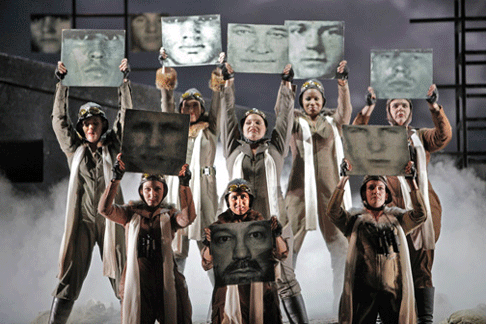Whispers about the price tag of the upcoming Met Ring suggest the proportions of a foreign war.
Gratefully as well the SFO Rheingold and Walküre have looked like opera, and not like crazed imitations of Star Wars, so they are easier to talk about. Though not necessarily a more or less compelling take on Wagner’s mega opera, this plain SFO Ring is unfolding as conceptually direct and wonderfully human.
Two years ago Rheingold got the San Francisco Ring off to a rocky start with its light weight cast and unfocused staging. Still it was a promising beginning with lots of ideas, some of which did not work all that well (the Nibelheim special effects as example). But lots of fun came out of its director Francesca Zambello who imposed a light touch on the divine machinations that initiate this long saga of greed and love, affectionately capturing the naivete, optimism and entrepreneurial fun that built our cities.
Conductor Donald Runnicles got right to the point in Walküre, not even allowing the applause that greeted him to die before attacking the complications motivated by Wotan’s insecurities. The War Memorial Opera House is particularly kind to Wagner, allowing the transparency within his massive orchestral sound to project the depth of his mountainous landscapes, and as well the myriad of musical motivations to coexist amongst themselves and within this cosmic nature. Mo. Runnicles exploited the Walküre score to its utmost, a remarkably rich reading.
 Eva-Maria Westbroek as Sieglinde, Raymond Aceto as Hunding and Christopher Ventris as Siegmund
Eva-Maria Westbroek as Sieglinde, Raymond Aceto as Hunding and Christopher Ventris as Siegmund
Die Walküre is no place for lightweights (as in fact Rheingold is not either), and San Francisco Opera rose to the occasion with a nearly stellar cast. The Siegmund of English tenor Christopher Ventris captured the youth of a young hero, his voice beating with energy, the Sieglinde of Dutch soprano Eva-Maria Westbroek soared vocally over the maelstrom with the unborn hero in her womb. But it was Swedish sopranto Nina Stemme’s Brünnhilde whose voice rose over all else as the energy and psychic spirit of Wotan, her creator and the world’s master builder.
This is an American Ring (the mountains are surely our California Sierras, though there is no defining land or river-scape). Hunding’s cabin is an American primitive wood facade with a screen door that can be found no where else in the world other than in middle America. American bass Raymond Aceto in a long sleeved winter undershirt with suspenders was a medium voiced Hunding, his strut and menace hiding this character’s predestined impotence. Paired with his unhappy, beaten and defeated wife, Sieglinde in a ill fitting, sad pale blue dress Hunding, strangely, evoked sympathy.
Costumer Catherine Zuber dressed German mezzo Janina Baechle as Wotan’s wife Fricka in a sort of purple beaux arts long gown in which she stolidly prevailed as a wet-blanket moral conscience. Meanwhile Wotan, American bass Mark Delavan from the Rheingold cast, muttered and spat effectively as some sort of railroad tycoon, but was vocally pallid even before running out of voice (June 22).
 Wendy Bryn Harmer as Gerhilde, Suzanne Hendrix as Schwerleite, Tamara Wapinsky as Helmwige, Pamela Dillard as Grimgerde, Daveda Karanas as Waltraute, Maya Lahyani as Siegrune, Priti Gandhi as Rossweise and Molly Fillmore as Ortlinde
Wendy Bryn Harmer as Gerhilde, Suzanne Hendrix as Schwerleite, Tamara Wapinsky as Helmwige, Pamela Dillard as Grimgerde, Daveda Karanas as Waltraute, Maya Lahyani as Siegrune, Priti Gandhi as Rossweise and Molly Fillmore as Ortlinde
Wotan’s Valhalla is seen through the window of a massive high rise. It was not specifically San Francisco but a high rise city profile that is specifically American, with echoes of Fritz Lang’s Metropolis. Set design for this American Ring is by Michael Yeargan who, with Mme. Zambello is working in a determined post-modern vocabulary, Wotan’s desk a huge table with four huge wooden claws as legs, the following scene moving onto the contemporary detritus under an abandoned elevated freeway, and finally an abstract space for the Valkyries and the Wotan farewell to Brünnhilde.
Beautiful, detailed lighting by Mark McCullough subtly caught a real life wolf-dog and his cub racing across the stage as Wotan was about to kill his son, connecting the innocence of real nature to the tragedies of cosmic destiny. McCullough magically captured the steel gray folds of Wotan’s coat covering the sleeping Brünnhilde as a ring of real fire began to encircle the stage, this real fire somehow making the fairytale ending of the Ring’s second installment humanly real, and unusually moving.
Everything in this Ring was ordinary, and that was its triumph. Rarely has operatic acting achieved this level of realism delicately sitting on the verge of expressionism. This accomplishment signals heroic efforts of stage direction plus determined commitment from singers. Miraculously this staging melted effortlessly into the Runnicles reading of the score, the abstract musical motivations from the pit rendered on the stage in movement that effortlessly and truly portrayed complex dramatic motivations. Gesamtkunstwerk indeed!
It was a good night at San Francisco Opera.
Michael Milenski
![Mark Delavan (Wotan) and Nina Stemme (Brünnhilde) [Photo by Cory Weaver courtesy of San Francisco Opera]](http://www.operatoday.com/_MG_8852.gif)

